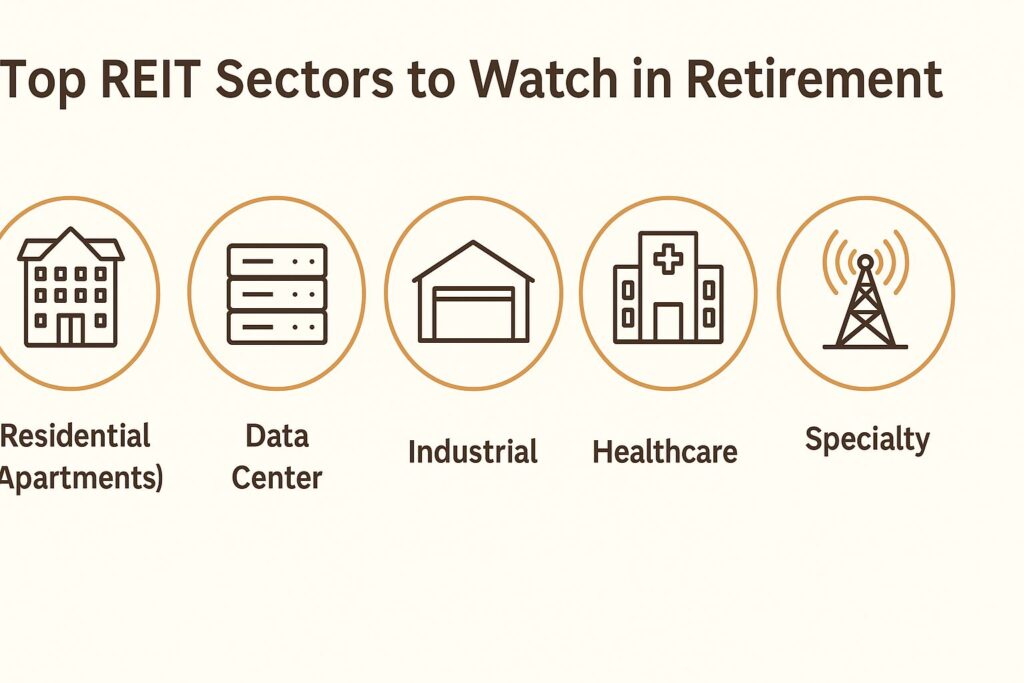
From apartments to data centers, discover which REITs are built for stability and income in today’s economy.
Real Estate Investment Trusts (REITs) are one of the most powerful tools in a retiree’s income strategy. They offer dependable dividends, inflation protection, and exposure to real estate without the hassle of managing properties.
But not all REITs are created equal.
Some real estate sectors are struggling with outdated business models and rising vacancies. Others are thriving—thanks to long-term trends like the growth of e-commerce, healthcare demand, and cloud computing.
In this post, you’ll discover the top REIT sectors to watch in today’s economy, especially if you’re seeking safe, reliable income during retirement.
✅ 1. Residential REITs – Especially Apartments and Manufactured Housing
With housing affordability hitting new lows, more Americans are turning to rentals—and that’s great news for apartment-focused REITs.
Top residential REITs:
- Focus on Sun Belt states with strong population growth
- Own mid-priced properties that appeal to working families and retirees
- Include manufactured housing communities, which have high occupancy and low maintenance
📌 Examples:
Equity Residential (EQR), Mid-America Apartment Communities (MAA), Sun Communities (SUI)
✅ 2. Data Center REITs – Powering the Digital Economy
Behind every Zoom call, cloud upload, and AI chatbot is a data center—and demand is exploding.
Data center REITs lease high-security digital storage space to tech giants like Amazon, Google, and Microsoft. With the rise of cloud computing and artificial intelligence, these REITs offer growth and income potential, even in a slowing economy.
📌 Examples:
Digital Realty Trust (DLR), Equinix (EQIX)
✅ 3. Industrial REITs – The Backbone of E-Commerce
Even as consumer spending slows, e-commerce continues to grow, and industrial REITs are the landlords behind the scenes.
These REITs own warehouses, logistics centers, and last-mile delivery hubs used by Amazon, UPS, and other giants. They benefit from:
- Long-term leases
- High occupancy
- Built-in rent escalations
📌 Examples:
Prologis (PLD), Rexford Industrial (REXR)
✅ 4. Healthcare REITs – Serving an Aging Population
With America’s population aging fast, healthcare REITs are positioned to grow steadily for years to come.
These REITs invest in:
- Senior housing
- Medical office buildings
- Skilled nursing facilities
The key is choosing REITs with strong operators and diversified property portfolios to manage risk.
📌 Examples:
Ventas (VTR), Welltower (WELL)
✅ 5. Specialty REITs – Unique Niches with Big Dividends
Some REITs don’t fit neatly into traditional categories—but offer excellent income potential:
- Farmland REITs (like Farmland Partners)
- Self-storage REITs (like Public Storage)
- Cell tower REITs (like American Tower)
These niche assets often provide high yields and lower correlation to traditional stock sectors—making them a great way to diversify.
✅ Bonus Tip: Consider REIT ETFs for Diversification
If picking individual REITs feels overwhelming, consider a REIT ETF like:
- Vanguard Real Estate ETF (VNQ)
- Schwab U.S. REIT ETF (SCHH)
These offer instant diversification and broad exposure to the best REIT sectors—ideal for hands-off retirees who still want monthly income.
✅ The Bottom Line
REITs can be a retirement game-changer—but what you own matters.
In today’s environment, focus on REIT sectors with:
- Long-term demographic tailwinds
- Stable tenants and strong lease agreements
- Opportunities to raise rents and grow payouts
Whether you favor residential rentals, digital infrastructure, or healthcare, the right REITs can deliver steady income and inflation protection for years to come.
📘 Want to learn more about earning consistent income with REITs?
Check out my book:
The Passive Landlord: Earn Safe 12% Returns Investing in REITs,
Available now on Amazon.com in paperback and eBook formats.
You’ll discover how to build a REIT-based portfolio that produces real income—without ever fixing a toilet or chasing a tenant.
⚠️ Disclaimer
This content is provided for informational and educational purposes only and does not constitute financial, investment, or tax advice. All investing involves risk, including the possible loss of principal. Consult a licensed financial advisor before making investment decisions. The author is not a licensed investment professional and does not offer personalized financial advice.